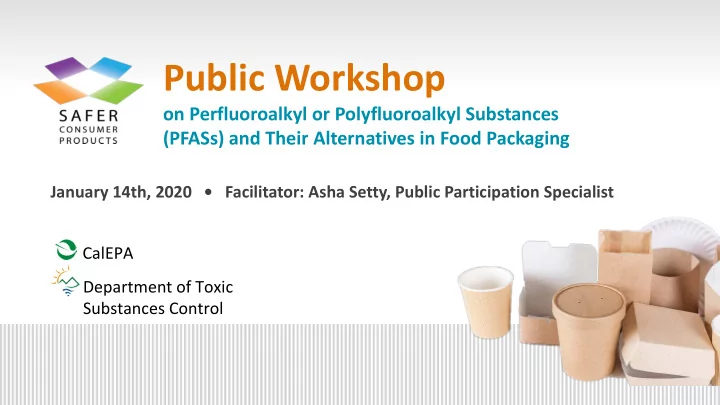

Public Workshop on Perfluoroalkyl or Polyfluoroalkyl Substances (PFASs) and Their Alternatives in Food Packaging January 14th, 2020 • Facilitator: Asha Setty, Public Participation Specialist CalEPA Department of Toxic Substances Control
Webcast attendees, submit your comments to: SaferConsumerProducts@dtsc.ca.gov Cal/EPA Department of Toxic Substances Control
Summary of DTSC’s findings André Algazi Chief, Chemical-Product Evaluation Section, Andre.Algazi@DTSC.ca.gov CalEPA Department of Toxic Substances Control
The Safer Consumer Products Framework
A Priority Product is a product-chemical combination that meets these criteria: • There are potential exposures to a Candidate Chemical in the product AND • One or more exposures have the potential to contribute to or cause significant or widespread adverse impacts
Preliminary screening results Definitions and scope Potential for exposure Potential adverse impacts Potential alternatives
Scope of product: Food packaging materials Any product containing PFASs placed into commerce in California that may be marketed or sold for the purpose of: • making paper, paperboard, or molded fiber resistant to oil, grease, and water; or • releasing the molded fiber food packaging products from the formation mold Definitions and scope Potential for exposure Potential adverse impacts Potential alternatives
Scope of Candidate Chemical: Perfluoroalkyl and polyfluoroalkyl substances (PFASs) PFASs are a class of nearly 5,000 man-made chemicals with at least one fully fluorinated carbon atom. All are Candidate Chemicals for the SCP program, due to listing by Biomonitoring California as Priority Chemicals in 2015. Definitions and scope Potential for exposure Potential adverse impacts Potential alternatives
Four main PFAS categories Wang et al. (2017) Definitions and scope Potential for exposure Potential adverse impacts Potential alternatives
Presence in Products There are currently 30 approved notifications for use in food contact substances under the FDA regulations. • This accounts for 19 distinct PFAS compositions from six manufacturers. Products are common in California homes and workplaces: • Paper and paperboard products including bakery bags, deli wrappers, microwave popcorn bags, french fry boxes, takeout containers, and pizza boxes. • Molded fiber products including bowls, soup containers, clamshells, plates, and food trays. Definitions and scope Potential for exposure Potential adverse impacts Potential alternatives
Monitoring data PFASs are ubiquitous in: the environment plants, animals, and humans human food and drinking water Definitions and scope Potential for exposure Potential adverse impacts Potential alternatives
Conceptual exposure model Migration Composting Landfill leachate Recycling Definitions and scope Potential for exposure Potential adverse impacts Potential alternatives
PFASs or their degradants exposure potential hazard traits Environmental persistence Mobility in the environment Bioaccumulation Definitions and scope Potential for exposure Potential adverse impacts Potential alternatives
PFASs or their degradants display exposure potential hazard traits Environmental persistence Mobility in the environment Bioaccumulation Lactational and transplacental transfer Definitions and scope Potential for exposure Potential adverse impacts Potential alternatives
Known toxicological hazard traits of longer-chain PFAAs Carcinogenicity Cardiovascular toxicity Endocrine toxicity Immunotoxicity Reproductive toxicity Definitions and scope Potential for exposure Potential adverse impacts Potential alternatives
Emerging toxicological hazard traits of shorter-chain PFAAs Developmental toxicity Endocrine toxicity Hematotoxicity Hepatotoxicity Neurodevelopmental toxicity Ocular toxicity Reproductive and developmental toxicity Definitions and scope Potential for exposure Potential adverse impacts Potential alternatives
All PFASs are either of concern or have degradation, reaction, or metabolism products of concern Definitions and scope Potential for exposure Potential adverse impacts Potential alternatives
Over 80 percent of PFASs may degrade to PFAAs Definitions and scope Potential for exposure Potential adverse impacts Potential alternatives
Potential adverse impacts to sensitive subpopulations, endangered species, and sensitive habitats Definitions and scope Potential for exposure Potential adverse impacts Potential alternatives
Potential alternatives Alternative materials (e.g. palm leaf, bamboo, polylactic acid (PLA)) Alternative processing Alternative coatings (e.g. PLA, clay, bio-wax) Chemical barriers (e.g. starch, aqueous dispersions of copolymers or waxes, chitosan) Definitions and scope Potential for exposure Potential adverse impacts Potential alternatives
Submit your comments on CalSAFER.dtsc.ca.gov by 11:59 pm on January 14 th , 2020 Definitions and scope Potential for exposure Potential adverse impacts Potential alternatives
Contact information Join our E-list to get updates: http://bit.ly/scpupdates General questions: SaferConsumerProducts@dtsc.ca.gov Media inquiries: Sanford.Nax@dtsc.ca.gov Technical questions: Andre.Algazi@dtsc.ca.gov and Simona.Balan@dtsc.ca.gov Meeting requests: Heather.Kessler@dtsc.ca.gov
ON BREAK- Public Workshop on Perfluoroalkyl or Polyfluoroalkyl Substances (PFASs) and Their Alternatives in Food Packaging January 14th, 2020 • Facilitator: Asha Setty, Public Participation Specialist CalEPA Department of Toxic Substances Control
Submit your comments to: SaferConsumerProducts@dtsc.ca.gov Cal/EPA Department of Toxic Substances Control
Recommend
More recommend